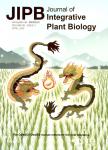CLE Peptides in Vascular Development
CLE Peptides in Vascular Development作者机构:Key Laboratory of Medicinal Resources and Natural Pharmaceutical Chemistry Ministry of Education National Engineering Laboratory forResource Developing of Endangered Chinese Crude Drugs in Northwest of China College of Life Sciences Shaanxi Normal University
出 版 物:《Journal of Integrative Plant Biology》 (植物学报(英文版))
年 卷 期:2013年第55卷第4期
页 面:389-394页
核心收录:
学科分类:0710[理学-生物学] 071001[理学-植物学] 07[理学]
基 金:supported by the National Natural Science Foundation ofChina (31271575 31200902) the Fundamental ResearchFunds for the Central Universities (GK201103005) the Specialized Research Fund for the Doctoral Program of Higher Education from the Ministry of Education of China(20120202120009)
主 题:CLE peptide vascular development (pro-)cambium xylem phytohormone Arabidopsis.
摘 要:The plant vascular system consists of two conductive tissues, phloem and xylem. The vascular meristem, namely the (pro-)cambium, is a stem- cell tissue that gives rise to both xylem and phloem. Recent studies have revealed that CLAVATA3/Embryo Surrounding Region-related (CLE) pep- tides function in establishing the vascular system through interaction with phytohormones. In particular, TDIF/CLE41/CLE44, phloem-derived CLE peptides, promote the proliferation of vascular cambium cells and prevent them from differentiating into xylem by regulating WOX4 expres- sion through the TDR/PXY receptor. In this review article, we outline recent advances on how CLE peptides function in vascular developmentin concert with phytohormones through mediating cell-cell communication. The perspective of CLE peptide signaling in vascular development is also discussed.



